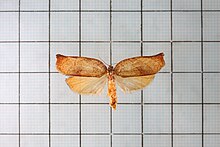Homona coffearia
| Homona coffearia | |
|---|---|

| |
| Scientific classification | |
| Domain: | Eukaryota |
| Kingdom: | Animalia |
| Phylum: | Arthropoda |
| Class: | Insecta |
| Order: | Lepidoptera |
| Family: | Tortricidae |
| Genus: | Homona |
| Species: | H. coffearia |
| Binomial name | |
| Homona coffearia (Nietner, 1861) | |
| Synonyms | |
| |
Homona coffearia, the tea tortrix[1] or camellia tortrix, is a moth of the family Tortricidae. The species was first described by Nietner in 1861.[2] It is widely distributed in the Oriental region.[3]
Description
The wingspan is 16–20 mm for males and about 23 mm for females. Adults are on wing between December and April in Sri Lanka.[4] There are two generations per year in China with adults appearing in late May.
Ecology
The larvae feed on Acacia auriculiformis, Arachis hypogaea, Bauhinia, Cajanus indicus, Calophyllum inophyllum, Camellia sinensis, Cinnamomum, Citrus, Coffea,[5] Crotalaria, Derris, Eucalyptus alba, Eugenia polyantha, Glochidion, Gossypium, Linum, Melochia indica, Nephelium, Pluchea indica and Pyrus.[6]
Life cycle
The tea tortrix has a life cycle which takes about 35 to 49 days to complete. Immediately after copulation, adult females lay 100 to 150 clusters of egg on the surface of the leaves of host plant. Eggs are scaly and minute with overlapping appearance. After 6 to 8 days of laying, larvae hatch from the eggs. Larvae complete five instars and become fully grown after 3 to 4 weeks. Fully grown caterpillar is about 22 mm in length. Pupation occurs in the folds of the leaves. After 6–8 days of pupal life, adult emerges.[7]
Control
Adults can be mechanically removed by hand and light traps. Parasite Macrocentrus homonae[8] used successfully in tea estates of Sri Lanka and India. In Sri Lanka, egg parasitoid Trichogramma erosicornis was used but results were not encouraging. New Guinea effectively used Theronia simillima and Camptotypus clotho to control the caterpillars and adults. Several chemical pesticides such as aminocarb, fenitrothion and formothion are effective, but they also destroy natural enemies of the moth.[9]
Distribution

Homona coffearia is found in Asia and on two occasions has been found in Great Britain. In Sussex. three Camellia plants imported from Japan, during the winter of 1964, produced three moths which emerged in April.[10] There are also two records of the moth from Torpoint in Cornwall.[11]
References
- ^ "Homona coffearia (tea tortrix)". Cabi. Retrieved 29 July 2018.
- ^ "Species Details: Homona coffearia Nietner, 1861". Catalogue of Life. Retrieved 29 July 2018.
- ^ Tortricidae (Lepidoptera) Collected in Taiwan, with Description of one new genus and eight new species Archived 2012-04-14 at the Wayback Machine
- ^ "Eurasian Tortricidae". Archived from the original on 2012-06-06. Retrieved 2011-11-18.
- ^ Diakonoff, A. (1982). "On a Collection of Some Families of Micro-Lepidoptera from Sri Lanka (Ceylon)". Zoologische Verhandelingen. 193: 1–124 – via Naturalis Biodiversity Center.
- ^ "Homona coffearia (Nietner)". CAR-National Bureau of Agricultural Insect Resources. Retrieved 11 March 2017.
- ^ "Flush Worm (Homona coffearia): Distribution , Life Cycle and Control". yourarticlelibrary. 2014-01-20. Retrieved 28 July 2018.
- ^ "Tea tortrix (Homona coffearia Nietner) in Sri Lanka". Tea Research Institute of Ceylon. Retrieved 28 July 2018.
- ^ "Plantwise Technical Factsheet - tea tortrix (Homona coffearia)". Plantwise Knowledge Bank. Retrieved 28 July 2018.
- ^ Bradley, J D; Tremewan, W G; Smith, Arthur (1973). British Tortricoid Moths. Cochylidae and Tortricidae:Tortricinae. London: The Ray Society. p. 100. ISBN 0-903874-01-6.
- ^ "Homona Walker, 1863". NBN atlas. Retrieved 7 April 2021.
